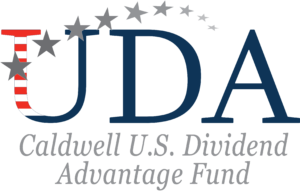The Caldwell U.S. Dividend Advantage Fund Series F (“UDA”) gained 1.4% versus +3.1% for the S&P 500 Total Return Index.1
Following very strong performance in the month of March, the Energy sector took a breather and was the worst performing sector declining 1.5% in April. Real Estate (+6.0%) was the best performing sector, primarily driven by gains in cellular tower, data center and industrial warehouse REITs. Communication Services (+5.6%) and Consumer Discretionary (+4.8%) were also relative outperformers following positive outlooks from major U.S. telecommunication service providers (contributing to the cell tower performance noted above), and a combination of strong performance in U.S. homebuilders and apparel retailers. Notwithstanding ongoing supply side challenges, management commentary regarding end demand has been exceedingly positive this earnings season across most sectors, supporting the narrative of pent up demand exiting COVID-19. As a result, investors are gaining more comfort rotating into cyclically exposed sectors.
Top contributors to UDA performance in April were Watsco Inc. (“WSO” +10.7%), S&P Global Inc. (“SPGI” +8.3%) and UnitedHealth Group (“UNH” +4.9%).2
Watsco is the largest heating, ventilation, air conditioning and refrigeration (“HVAC/R”) distributor in North America. The company is benefiting from strong demand as consumers spend more time at home, placing greater emphasis on indoor air quality. Ahead of stricter upcoming energy efficiency regulations, an installed base of 110 million HVAC units that operate under old efficiency standards provide another tailwind to replacement demand. In addition, WSO’s industry leading tech helps contractors sell more high-efficiency systems, helping them grow their business faster, while driving higher basket sizes and increased stickiness to Watsco. As a result, the company reported a healthy top and bottom line beat in its first quarter (“Q1”) results on strong margins and operating leverage. Lastly, WSO acquired its first HVAC distributor in the mid-west that is expected to be immediately accretive to 2021 earnings, continuing its long held strategy of growth by acquisition.
S&P Global continues to benefit from robust global debt issuance in its ratings business, particularly high-yield bonds and structured loans driven by strong refinancing and M&A activity. In combination with solid cost controls, SPGI reported better than expected top line, margin and earnings performance in its Q1 results. While a relatively small part of the company today, SPGI’s ESG and China initiatives also continue to gain traction and are expected to become a material part of the story over the next few years.
Similar to the other top performers, UnitedHealth’s Q1 results beat across the board. Lower than normal elective procedure volumes (related to restrictions and capacity constraints in some U.S. hospitals) contributed to below-average health care utilization and thus medical costs in its insurance division. While elective procedures will eventually return, potentially elevated utilization levels are expected to be temporary and investors could see upside to 2021 results if a return to baseline takes longer than anticipated. The OptumInsight consulting business is benefiting from more normalized activity among payer and provider customers and while it is only 3% of overall revenue today, it generates significantly higher than company-average margins and management expects material growth in the business going forward, particularly as the Change Health care acquisition is integrated. Lastly, UNH continues to shift patients to a full risk-based care delivery model utilizing its OptumCare network which should support strong double-digit growth in revenue per patient over the long term.
1Standard performance as at April 30, 2021:
Caldwell U.S. Dividend Advantage Fund Series F: 1 Year: 16.5%, 3 year: 11.9%, 5 year: 11.2%, Since Inception (June 19, 2015): 9.3%.
S&P500 Total Return Index: 1 Year: 29.3%, 3 year: 17.1%, 5 year: 17.0%, Since Inception (June 19, 2015): 14.7%.
2Actual investments, first purchased: WSO - 12/8/2020, SPGI - 11/7/2018 and UNH - 12/31/2015.
All data is as of April 30, 2021 sourced from CapitalIQ, unless otherwise indicated. Fund returns are from FundData. UDA, Index total return numbers, sector returns and individual stocks returns are in CAD terms. The Fund was first offered to the public as a closed-end investment since May 28, 2015. Effective November 15, 2018 the Fund was converted into an open-end mutual fund such that all units held were redesignated as Series F units. Performance prior to the conversion date would have differed had the Fund been subject to the same investment restrictions and practices of the current open-end mutual fund.
The information contained herein provides general information about the Fund at a point in time. Investors are strongly encouraged to consult with a financial advisor and review the Simplified Prospectus and Fund Facts documents carefully prior to making investment decisions about the Fund. Commissions, trailing commissions, management fees and expenses all may be associated with mutual fund investments. Rates of returns, unless otherwise indicated, are the historical annual compounded returns including changes in unit value and reinvestment of all distributions and do not take into account sales, redemption, distribution or optional charges or income taxes payable by any unitholder that would have reduced returns. Mutual funds are not guaranteed; their values change frequently and past performance may not be repeated. The payment of distributions should not be confused with a fund’s performance, rate of return or yield. If distributions paid are greater than the performance of the fund, your original investment will shrink. Distributions paid as a result of capital gains realized by a fund, and income and dividends earned by a fund, are taxable in your hands in the year they are paid. Your adjusted cost base (“ACB”) will be reduced by the amount of any returns of capital and should your ACB fall below zero, you will have to pay capital gains tax on the amount below zero.
Publication date: May 11, 2021.
